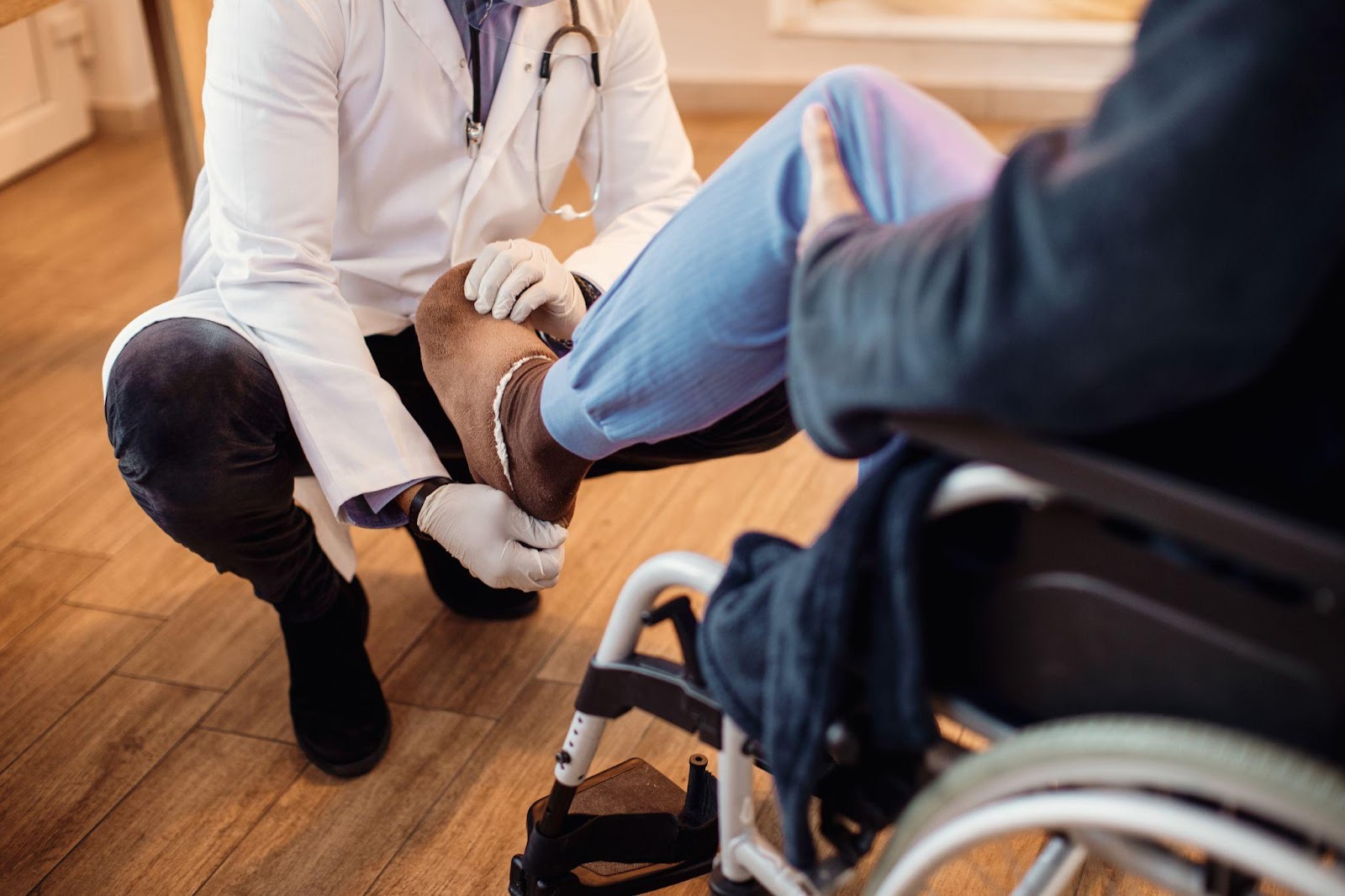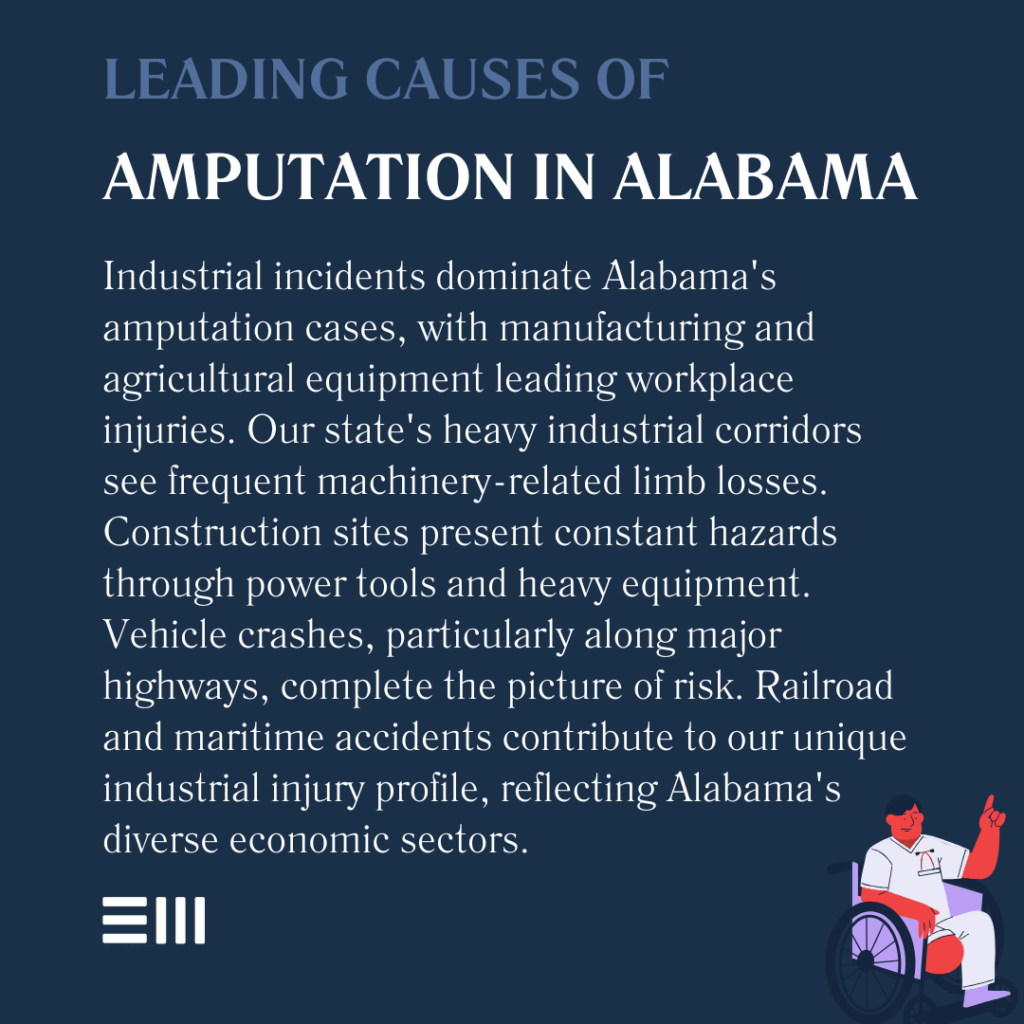
Every day in America, surgeons perform between 300 and 500 amputation procedures, resulting in 185,000 people losing limbs annually.
Behind these staggering numbers are individuals and families whose lives transform instantly, facing profound physical challenges, emotional trauma, and overwhelming financial burdens.
In Alabama, preventable accidents in workplaces, on highways, and in medical facilities continue to drive these life-altering injuries, forever changing victims’ ability to work, maintain independence, and engage in daily activities.
Understanding Amputation Injuries
Medical professionals classify over 185,000 amputations annually in the United States as catastrophic injuries—permanent, life-altering events that drastically impact a person’s ability to work and live independently.
These injuries range from partial finger or toe loss to complete limb amputation, each presenting unique challenges for survivors.
Types of Amputation Injuries:
- Traumatic amputations from accidents;
- Surgical amputations due to severe injury;
- Partial vs. complete amputations;
- Upper extremity amputations (fingers, hands, arms);
- Lower extremity amputations (toes, feet, legs); and
- Multiple limb amputations.
Beyond the immediate physical trauma, amputation survivors face a complex journey of medical procedures, rehabilitation, and life adjustments.
Common Causes in Alabama
Our state’s industrial and agricultural sectors, combined with high-traffic corridors, create multiple risk factors for catastrophic limb injuries.
Understanding these causes helps prevent future incidents and establishes liability in injury claims.
Primary causes include:
- Industrial accidents and machinery malfunction;
- Motor vehicle collisions;
- Construction site accidents;
- Agricultural equipment incidents;
- Medical malpractice or complications;
- Severe burns or infections; and
- Railroad and maritime accidents.
These incidents often result from negligence, equipment failure, or unsafe working conditions – factors that determine legal options for survivors.

Medical and Recovery Process
Understanding this process helps victims prepare for the challenges ahead.
Key treatment phases:
- Emergency medical response;
- Surgical procedures;
- Post-operative care;
- Physical therapy;
- Occupational therapy;
- Prosthetic fitting and training;
- Psychological counseling;
- Pain management; and
- Adaptive equipment training.
Recovery extends beyond physical healing to include emotional adaptation and lifestyle modifications.
Financial Impact and Compensation
The lifetime cost of an amputation injury often exceeds $509,275, accounting for ongoing medical care, lost wages, and necessary accommodations. Understanding these expenses helps victims pursue appropriate compensation.
Common expenses include:
- Immediate medical treatment;
- Multiple surgical procedures;
- Prosthetic devices and maintenance;
- Rehabilitation services;
- Home and vehicle modifications;
- Lost income and benefits;
- Future medical care;
- Personal assistance services; and
- Mental health support.
Documenting these expenses proves crucial for securing fair compensation through legal channels.
Legal Rights and Options
Alabama law provides specific protections for amputation injury victims, with a statute of limitations of two years for filing personal injury claims. Understanding these rights helps victims protect their interests.
Legal considerations include:
- Determining liability;
- Workers’ compensation claims;
- Third-party lawsuits;
- Insurance negotiations;
- Documentary evidence;
- Expert testimony;
- Settlement evaluation; and
- Trial preparation.
Each case requires careful evaluation to identify all potential sources of compensation.

Frequently Asked Questions About Amputation Injuries in Alabama
Supporting amputation survivors means addressing their most pressing concerns about legal rights, medical care, and future planning.
Here are answers to common questions we receive from clients facing these challenges.
How Long Do I Have to File an Amputation Injury Claim in Alabama?
In Alabama, you generally have two years from the date of the injury to file a personal injury lawsuit for amputation cases.
However, this timeline can vary depending on the circumstances. For workers’ compensation claims, you must notify your employer within five days of the incident.
If your amputation resulted from medical malpractice, the timeline might differ. Acting promptly ensures protection of your legal rights and access to crucial evidence.
What Compensation Can I Receive for an Amputation Injury?
Amputation injury compensation typically covers both economic and non-economic damages. Economic damages include medical expenses, lost wages, future medical care, prosthetics, rehabilitation costs, and necessary home modifications.
Non-economic damages compensate for pain and suffering, emotional distress, loss of quality of life, and permanent disability. In cases involving severe negligence, punitive damages may also apply.
Does Workers’ Compensation Cover All My Amputation-Related Expenses?
While workers’ compensation provides important benefits, it typically only covers medical expenses and a portion of lost wages.
It doesn’t compensate for pain and suffering or full lost wages. However, if a third party contributed to your injury (equipment manufacturer, contractor, or property owner), you may pursue additional compensation through a separate personal injury claim while receiving workers’ compensation benefits.
What if I Can’t Return to My Previous Job After an Amputation?
If you cannot return to your previous occupation, you may be eligible for vocational rehabilitation services, long-term disability benefits, and compensation for lost earning capacity.
Workers’ compensation provides vocational retraining benefits, and personal injury claims can include compensation for reduced future earning potential.
Social Security Disability benefits might also be available depending on your situation.
How Do I Pay for Medical Bills While Waiting for My Case to Settle?
Several options exist for managing medical expenses during your case. Health insurance, workers’ compensation (if work-related), and medical payment coverage from auto insurance (if applicable) can cover immediate costs.
Some medical providers may agree to delay payment pending case resolution. Additionally, letters of protection can help secure necessary medical treatment while your case proceeds.
Can I Still File a Claim if My Amputation Was Partially My Fault?
Alabama follows the contributory negligence rule, which can affect your ability to recover compensation if you were partially at fault.
However, determining fault is complex, and multiple factors influence liability. Even if you think you might be partially responsible, it’s important to have your case evaluated by an experienced attorney who can assess all aspects of the incident and identify all potentially liable parties.
What Role Do Expert Witnesses Play in Amputation Cases?
Expert witnesses provide crucial testimony to establish liability, damages, and future needs. Medical experts explain the injury’s extent and required treatment.
Life care planning experts detail future medical and assistance needs. Vocational experts assess work capability and earning capacity impact. Economic experts calculate lifetime financial losses.
Engineering experts may evaluate equipment failure or accident circumstances. Their testimony helps build a comprehensive case for fair compensation.
Get Expert Legal Support Today
Don’t face this challenging journey alone. Our experienced catastrophic injury attorneys stand ready to help you understand your rights and pursue the compensation you deserve.
Contact us today for a free, confidential consultation to discuss your case and explore your options.
Can't find what you're looking for? Search our site below.










